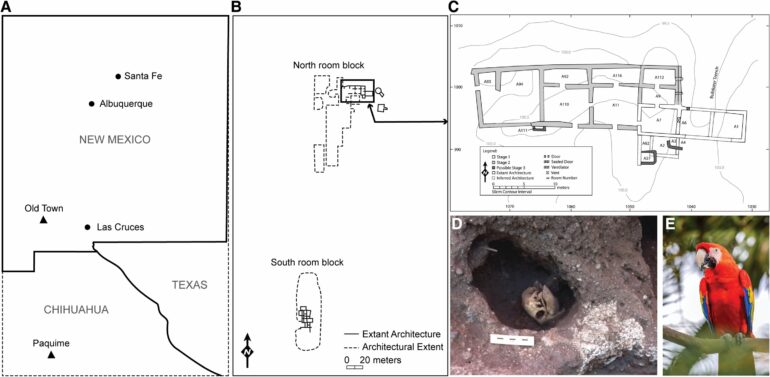People were breeding scarlet macaws (Ara macao) in, what is today, New Mexico in the 1100s, according to examination of eggshell found at the Old Town archaeological site. The paper is published in the journal PNAS Nexus.
Cyler Conrad and colleagues examined six eggshell fragments associated with the articulated remains of a macaw. The eggshells are indirectly dated to the early 1100s by previous bone radiocarbon dating of the macaw. Using a non-destructive scanning electron microscope, the authors looked for evidence of fetal development inside the eggs, which can be inferred from reabsorption of a layer of eggshell known as the mammillary cone.
Five specimens showed clear evidence of reabsorption, and the samples included at least two separate eggs, based on the developmental ages identified. The presence of fertilized scarlet macaw eggs at this site strongly suggests macaw breeding was occurring at Old Town in the 1100s.
This is the first evidence of macaw breeding north of Paquimé, in Northwestern Mexico, where macaw breeding was known to occur after 1275. According to the authors, the findings may help shed light on the practice of breeding and keeping macaws in the Americas. The birds are native to the rainforests of Mexico and Central America but were transported and kept by people as far north as the desert Southwest in what is now the United States as early as the 600s. Contemporary experts are not sure precisely why scarlet macaws were bred and translocated.
More information:
Cyler Conrad et al, Scarlet macaw (Ara macao) breeding at the Mimbres archaeological site of Old Town (early AD 1100s) in Southwestern New Mexico, PNAS Nexus (2023). DOI: 10.1093/pnasnexus/pgad138
Citation:
Study finds evidence of ancient breeding of scarlet macaws (2023, June 14)



